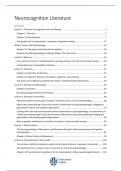Summary
Neurocognition literature (detailed summary of all required literature)
- Course
- Institution
Hi all! Here is the summary I wrote during the course Neurocognition. It is really detailed and I included all the required literature of the course. Good luck studying! :)
[Show more]



